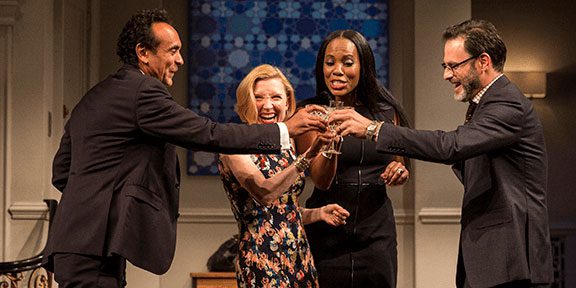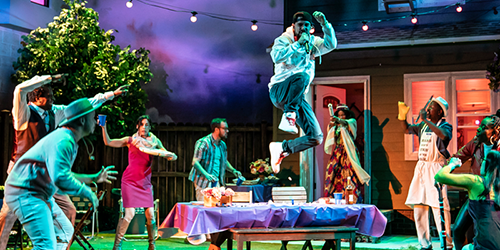Goodman Theatre, recipient of the Special Tony Award for Outstanding Regional Theatre, is internationally recognized for its artists, productions and educational programs. Under the leadership of Artistic Director Susan V. Booth and Executive Director John Collins, the Goodman is committed to producing classic and contemporary works, giving full voice to a wide range of artists and visions.
Goodman Theatre was established in July 1922, by a gift of $250,000 from William and Erna Goodman to the Art Institute of Chicago for the purpose of building a theater to memorialize their son, Kenneth Sawyer Goodman. Before his death at the age of 35 in the influenza epidemic of 1918, Kenneth Sawyer Goodman had written, published and produced a number of plays in non-commercial productions in Chicago, and had expressed his vision of an ideal theater, one that would combine professional training with the highest possible performance standards.
Four months after the gift was received, the Art Institute began construction of the new theater on the northeast corner of its property, at Monroe and Columbus Drive. They soon hired the theater’s first artistic director, Thomas Woods Stevens, a former colleague of Kenneth Sawyer Goodman’s and a noted educator who had established America’s first theater degree-granting program at Carnegie Mellon University.
The new theater, encompassing a drama school and a professional acting company, opened its doors on October 20, 1925. Three of Goodman’s one-act plays were presented at the theater’s dedication ceremony. Two nights later the Goodman began its first regular season with John Galsworthy’s The Forest. Stevens built the new theater’s repertory with a mix of classics, contemporary hits and experimental and new plays, a formula that the theater has generally adhered to ever since.
Stevens led the Goodman for five years before resigning in 1930 over a dispute about the deficit the theater had accumulated. The Art Institute replaced him with Hubert Osbourne, a former student of Stevens’, who ran the theater for a year until the Art Institute decided that the professional acting company would prove too costly to maintain. The professional acting company was disbanded, but the Art Institute kept the doors of the drama school open.
Maurice Gnesin, who Stevens hired during the 1929/1930 Season, stepped in as the new head of the Goodman School of Drama when Stevens resigned. A scholarly Russian, Gnesin ran the school for the next 27 years, aided by his colleague and fellow Russian, the actor David Itkin. The Goodman School built a formidable reputation over the following decades and graduated many stellar theater artists, including Karl Malden, Sam Wanamaker, Geraldine Page, Shelley Berman, Harvey Korman, José Quintero, Linda Hunt and Joe Mantegna. The school was also noted for its children’s theater, run for many years by Charlotte Chorpenning, whose adaptations of children’s stories made her the most produced playwright in Goodman Theatre history. Thousands of Chicagoans got their first taste of theater at the Goodman’s weekend matinees.
In 1957 Maurice Gnesin passed away and David Itkin retired. The Art Institute offered the artistic directorship to John Reich, a native Austrian who had trained with legendary director Max Reinhardt. Reich accepted the position under the condition that the theater commit to re-establishing the professional acting company. Over the next decade, Reich slowly rebuilt the Goodman’s subscribership, bringing in stars to lead casts of student actors and attracting new attention to the theater. In the fall of 1969, the Goodman opened the new season featuring the first fully professional acting company at the theater in nearly 40 years. But maintaining a resident company of professionals proved expensive and led to the largest deficits in the theater’s history. Two years later, the theater began hiring actors on a show-by-show basis. In 1972, John Reich was asked to resign. A new managing director, Ken Myers, brought in during Reich’s last year to oversee the theater’s business side and ran the theater for a year before resigning himself.
In 1973, William Woodman, a director with considerable experience in regional theaters, was appointed artistic director. Woodman saw the theater through a period of restructuring. In 1976, the Goodman separated itself from the Art Institute, incorporating as the Chicago Theatre Group, Inc, which allowed it to pursue fundraising independently. In 1978, the theater divested itself of the Goodman School, which was acquired by DePaul University. Woodman also instituted Stage 2, a venue for new work within the Goodman framework. Gregory Mosher, Woodman’s assistant, and Roche Schulfer, a young business office assistant, were placed in charge of Stage 2, which became a proving ground for up-and-coming Chicago actors, directors and writers, one of whom was David Mamet, whose play American Buffalo premiered at Stage 2 in 1975.
After running the Goodman for five seasons, William Woodman resigned in 1978 and Gregory Mosher was appointed artistic director. A year later Roche Schulfer was appointed managing director. Mosher led the theater through the 1984/1985 Season, bringing much new work to the Goodman, including plays by Nobel Prize winners Wole Soyinka and Derek Walcott, and new plays by American masters Edward Albee and Tennessee Williams, including Williams’ last produced play, A House Not Meant to Stand. In 1985 Mosher left the Goodman to take over Lincoln Center Theater in New York City.
The Goodman replaced Mosher with Robert Falls, a young director who was a product of the off-Loop theater boom of the 1970s. Falls, who was born in downstate Illinois and grew up in the Chicago suburbs, left the University of Illinois and immediately began directing in Chicago. At the age of 23 he was appointed to lead Wisdom Bridge Theatre, where he stayed for eight years before being named the Goodman’s artistic director. Falls brought with him to the Goodman two colleagues from the off-Loop theater scene, Frank Galati and Michael Maggio, to serve as associates, and a young director from New York, David Petrarca. In the 1990s Falls added to this “college” of directors, naming such theater artists as Mary Zimmerman, Chuck Smith, Henry Godinez and Regina Taylor to the Goodman’s artistic staff. This group later expanded to include Brian Dennehy, Rebecca Gilman, Steve Scott, Dael Orlandersmith, Henry Wishcamper and Kimberly Senior, and was known as the Goodman’s Artistic Collective.
Highlights of Robert Falls’ 35-year tenure at the Goodman, which concluded in 2022, included dozens of world premieres and transfers of Goodman productions to other theaters. In his first season, Falls began his partnership with actor Brian Dennehy with the production of Bertolt Brecht’s Galileo. Their work together since then includes Death of a Salesman and Long Day’s Journey Into Night (both of which went on to Tony Award-winning presentations in New York), Desire Under the Elms and Hughie.
In the mid-1980s, concerned about the adequacy of its aging theater behind the Art Institute, the Goodman began to explore the possibility of a new facility. Led by Irving J. Markin and the Goodman Board of Trustees, the theater came to the conclusion that rebuilding on the site of the old theater was not a viable proposition and other locations in downtown Chicago were scouted. The City of Chicago, in the process of revitalizing the North Loop, urged the Goodman to consider the site of two old commercial theaters, the Selwyn and the Harris theaters, on North Dearborn Street. In the early 1990s, the Goodman committed to building on the new site and fundraising efforts began led by Chairs of the Board Sondra Healy, Jim Annable, Irving J. Markin and honorary president Lewis Manilow. A major gift was received from Albert Ivar Goodman, a distant cousin of Kenneth Sawyer Goodman, and from his mother, Edith-Marie Appleton, which ensured that the theater would keep the Goodman name. Construction then began under the supervision of the theater planning committee headed by Peter C.B. Bynoe. The new Goodman Theatre opened in December, 2000, with August Wilson’s play, King Hedley II.
Other notable productions in the Goodman’s recent history include Robert Falls’ stagings of Measure for Measure, The Iceman Cometh starring Brian Dennehy and Nathan Lane, The Night of the Iguana with Cherry Jones and William Petersen, The Young Man from Atlanta starring Rip Torn and Shirley Knight and his reimagining of Chekhov’s The Seagull; Michael Grief’s world premiere of War Paint, by Doug Wright, Michael Korie and Scott Frankel, starring Patti Lupone and Christine Ebersole; Frank Galati’s world premiere of John Kander and Fred Ebb’s musical The Visit, featuring a book by Terrence McNally and starring Chita Rivera; David Petrarca’s world premiere production of Marvin’s Room; Chuck Smith’s acclaimed revivals of Ma Rainey’s Black Bottom and The Amen Corner, as well the Chicago premieres of The Good Negro and Race under his direction; Mary Zimmerman’s premiere productions of The Jungle Book, The Notebooks of Leonardo da Vinci, Journey to the West, The Odyssey and the Philip Glass opera Galileo Galilei; the world premieres of Regina Taylor’s Drowning Crow and Oo-Bla-Dee; the Chicago premieres of Zoot Suit and Boleros for the Disenchanted, both staged by Henry Godinez; all ten works in August Wilson’s cycle of plays exploring the African American experience in the twentieth century, including the premiere productions of Seven Guitars, King Hedley II and Gem of the Ocean; the world premiere of Lynn Nottage’s Ruined (also a Goodman commission); the world premiere of Sarah Ruhl’s Stage Kiss; several premieres of David Mamet’s plays, including American Buffalo and A Life in the Theatre; and premieres of Rebecca Gilman’s plays Spinning into Butter, Boy Gets Girl, Blue Surge, Dollhouse, A True History of the Johnstown Flood, Luna Gale and Twilight Bowl.
Special events include the Goodman’s annual holiday production of Charles Dickens’ A Christmas Carol, a Yuletide tradition for thousands of Chicago families since 1978, and the annual New Stages Festival, a showcase of new work.
The Goodman’s Department of Education and Engagement provides free programming for theater lovers of all ages. The School Matinee Series gives 2,700 Chicago public high school students a year the opportunity to attend free matinee performances and post-show discussions with actors, and provides copies of scripts, study guides, online resources and professional training seminars for teachers. The Goodman partners with the Walt Disney Company to create Disney Musicals in Schools, which provides elementary schools students with the opportunity to perform Disney musicals on the Goodman stage. Each summer, the PlayBuild program engages 14- to 19-year-old students from across Chicagoland in an intensive six-week theater training program, culminating in an original devised performance by the participants. Young women in their sophomore and junior years of high school are eligible for the Cindy Bandle Young Critics program, which provides training in theater criticism, mentoring from professional journalists and opportunities to interview stage stars. Past participants in Goodman programs stay involved through the Youth Arts Council, acting as ambassadors for theater in their communities and schools. Using Goodman productions as a springboard, dramatic integration weekend seminars instruct teachers from across Chicago and across disciplines on how to use the arts to teach everything from science to English to history. In addition, the theater’s internship program provides hands-on training for students, graduates and young professionals interested in careers in professional theater. Lifelong learners can participate in GeNarrations, a writing workshop for senior citizens.
Staying true to its roots, Goodman Theatre continues its mission to enrich the American theater by producing bold and varied seasons and providing an essential cultural contribution to a diverse and vibrant city.
























